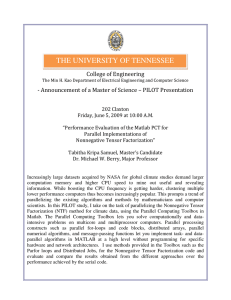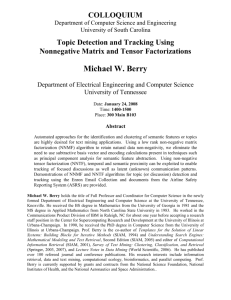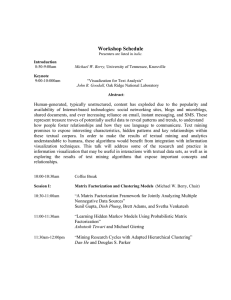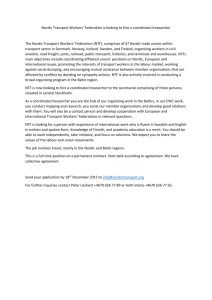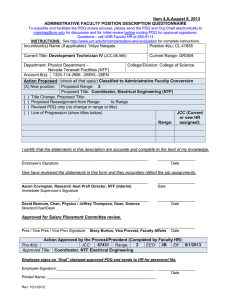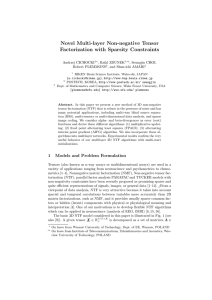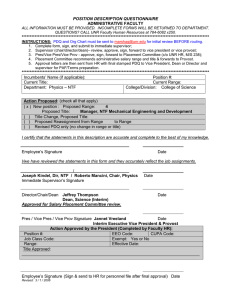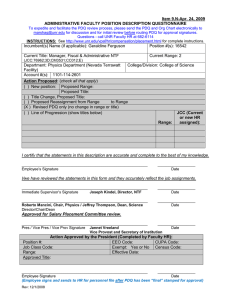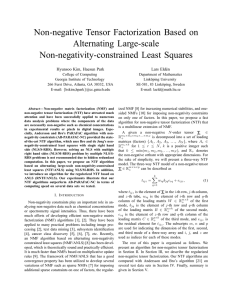Motivations
advertisement
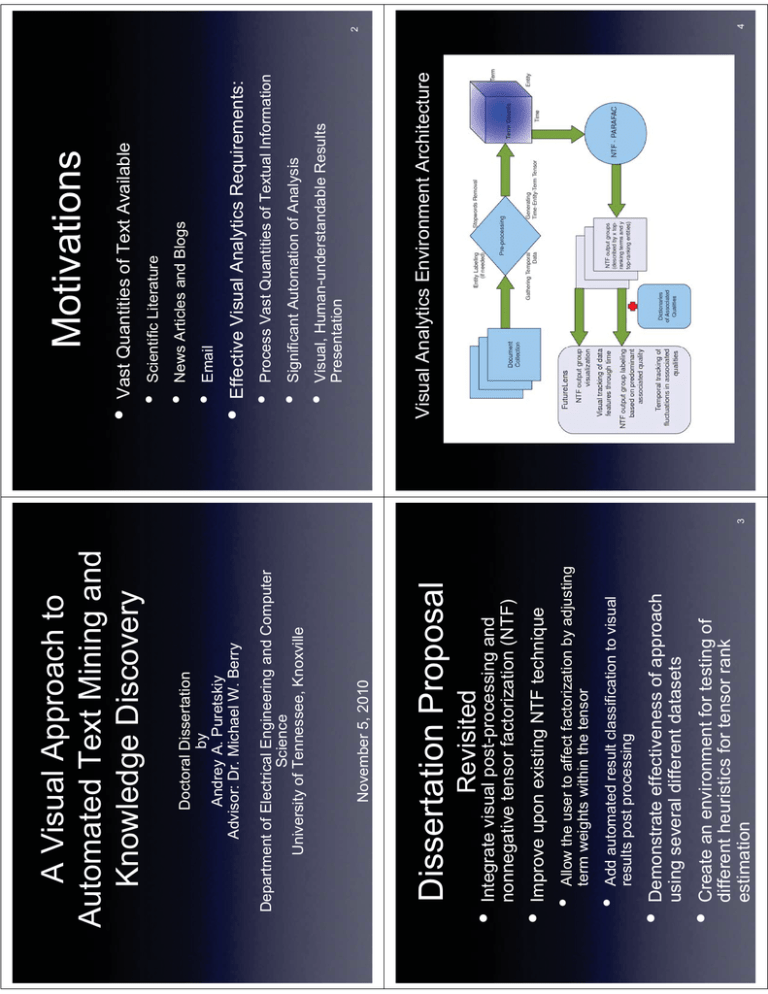
• • • • Add automated result classification to visual results post processing Allow the user to affect factorization by adjusting term weights within the tensor Create an environment for testing of different heuristics for tensor rank estimation Demonstrate effectiveness of approach using several different datasets • • Improve upon existing NTF technique Integrate visual post-processing and nonnegative tensor factorization (NTF) Revisited Dissertation Proposal November 5, 2010 Department of Electrical Engineering and Computer Science University of Tennessee, Knoxville Doctoral Dissertation by Andrey A. Puretskiy Advisor: Dr. Michael W. Berry A Visual Approach to Automated Text Mining and Knowledge Discovery 3 Email News Articles and Blogs Scientific Literature • • • Visual, Human-understandable Results Presentation Significant Automation of Analysis Process Vast Quantities of Textual Information Effective Visual Analytics Requirements: • • • Vast Quantities of Text Available Visual Analytics Environment Architecture • • Motivations 4 2 • • • • Illustration of a Time-by-Author-by-Term Tensor Decomposition Tensor Factorization Summary PARAFAC: Parallel Factors Analysis (Harshman, 1970) Factorization: Process of rewriting a tensor as a finite sum of lower-rank tensors History: Hitchcock (1927), Cattell (1944), Tucker (1966) Tensor: Multidimensional array Tensor Factorization 7 5 R Given tensor X and rank R, define the factor matrices as combinations of vectors from rank-one components • • • • • Each feature may be described by a list of terms and tagged entities Extracts features from textual data Python Translation (Mr. Papa Diaw, Advisor: Dr. Michael Berry) Matlab£ Code (Dr. Brett Bader, Sandia) Nonnegative tensor factorization algorithm: PARAFAC with nonnegativity constraint Nonnegative Tensor Factorization (NTF) Cycle “over all the factor matrices and perform a least-squares update for one factor matrix while holding all the others constant.” (Bader, 2008) X | A B C | ¦ ar br cr r 1 • Alternating Least Squares: • PARAFAC Methodology Tensor Factorization: 8 6 900 1455 Kenya 20012009 VAST 2007 391 696 Avg. Document Length (terms) 3.95 4.54 Matlab NTF Execution Time (minutes) 16.13 17.15 Python NTF Execution Time (minutes) ############ Group 15 ########## Scores Idx Name 0.2485621 7120 bruce longhorn 7120 0.2485621 7122 longhorn 7122 0.2485621 7128 chelmsworth 7128 0.2485621 7124 gil 7124 0.2485621 7121 virginia tech 7121 0.2485621 7125 mary ann ollesen 7125 … Scores Idx Term 0.2958673 6907 monkeypox 0.2054770 7468 outbreak 0.2008147 6358 longhorn 0.1594331 4644 gil 0.1552401 1856 chinchilla 0.1434742 11049 travel 0.1391984 9322 sars 0.1379675 1857 chinchillas 0.1342139 2372 continent 0.1294389 3888 expect 0.1215461 9711 sick 0.1161760 7469 outbreaks 0.1144558 3883 exotic 0.1122925 7824 pets 0.1026513 8088 pot-bellied 0.1026513 7229 novelty 0.1019125 1742 cesar 0.1004109 10280 strain 0.1000808 5878 jul … Sample NTF Output • Times were averaged over 10 trials • While not as fast as Matlab£, Python still allows real-time analysis • Future improvements in Python NTF code performance may be possible Number of Document s Dataset Performance Comparison 11 9 • • • • • • term-entity matrix for time point k Nonnegative PARAFAC + FutureLens: Software for Text Visualization and Tracking. Text Mining Workshop, Proceedings of the Ninth SIAM International Conference on Data Mining, Sparks, NV, April 30-May 2, 2009, ISBN: 978-0-898716-82-5. A more complete description of capabilities and effectiveness published in: G.L. Shutt, A.A. Puretskiy, M.W. Berry: Ability to Create Phrases Ability to Create Collections of Terms Ability to Sort Terms Ability to Search through Terms + ... Multilinear algebra term-entity-time array Automatically Loads All Terms Found in Input Dataset (except those on the list of exclusions) Features FutureLens Third dimension offers more explanatory power: uncovers new latent information and reveals subtle relationships Textual Data (e.g., collection of news articles) Build a 3-way array such that there is a term-entity matrix for each time point. NTF: Multidimensional Data Analysis 12 10 Introduction of automatic NTF results classification through the use of pre-existing and user-modifiable dictionaries importance (or trustworthiness) of terms or subsets of terms • User is able to define relative Allowing the user to affect the NTF process through Integrated Analysis Environment controls: Integration of Pre-processing, NTF, and FutureLens into a single analysis environment • Addition of temporal information into the dataset in SGML-tagged format • User-customized entity tagging (SGML format) • NTF input file creation • Tensor term weight adjustment • Python NTF PARAFAC execution • FutureLens launching for continuing visual analysis of NTF results Capabilities Integrated Analysis Environment • • • Completed Goals 15 13 Integrated Analysis Environment • Portability • Linux, OS X, Windows • Look and feel of application native to the user’s operating system • Easily modifiable due to Python’s excellent readability • Implemented in Python • Simple look to avoid feature overload • Easy to use without much experience • Integration of multiple important capabilities • Objectives • A single application Features and Design Objectives Integrated Analysis Environment 16 14 • Feature includes a default (“none of the above”) category • Feature allows the analyst to quickly sort NTF output groups by analyst-defined categories • Focus exclusively on category or categories of interest • Automated labeling feature functions much faster than analyst labeling ever could NTF results • Motivation: Increase efficiency of human analysis of Automated NTF Output Group Labeling • Subset may have been deemed particularly trustworthy • Analyst may need to create a model that focuses strongly on a particular aspect of the data • Strong interest in a subset of terms • Terms may have been deemed “untrustworthy” • Terms may likely be irrelevant to particular analysis model • The above may be insufficient to eliminate terms as stopwords 19 17 • Visual category labeling allows the analyst to filter out uninteresting groups and focus on the ones most pertinent to the focus of analysis • FutureLens quickly labels NTF output groups based on the set of category descriptor files loaded at the time • Very easy to create, distribute, view, share feedback, modify models • Plain-text files containing lists of terms • Easy for computer-inexperienced users Design and Utilization Automated Labeling • Each file corresponds to a particular analysis model • Very easy to create, distribute, view, share feedback, modify models • Integrated Analysis Environment quickly creates a term-weight modified NTF input file based on such input • Plain-text files containing lists of terms • Easy for computer-inexperienced users The Simple Approach Motivation • Lack of interest in subset of terms Tensor Term Weights Adjustment Tensor Term Weights Adjustment 20 18 • Bioinformatics applicability • Medical research literature • Gene-by-Term-by-Expression data may reveal additional functional relationships among genes • Integration of Spatial Information • Geo-coding • Allow the user to track term usage changes and fluctuations through geographical locales Future Research Directions Integrated Analysis Environment Demo 23 21 • • • • Applications and Theory, M.W. Berry and J. Kogan (Eds.), Wiley, Chichester, UK, pp. 107-127, 2010. A.A. Puretskiy, G.L. Shutt, and M.W. Berry, ”Survey of Text Visualization Techniques,” in Text Mining: G.L. Shutt, A.A. Puretskiy, M.W. Berry: FutureLens: Software for Text Visualization and Tracking. Text Mining Workshop, Proceedings of the Ninth SIAM International Conference on Data Mining, Sparks, NV, April 30-May 2, 2009, ISBN: 978-0-89871682-5. Brett W. Bader, Andrey A. Puretskiy, and Michael W. Berry. Scenario Discovery Using Nonnegative Tensor Factorization. In Jose Ruiz-Shulcloper and Walter G. Kropatsch, editors, Progress in Pattern Recognition, Image Analysis and Applications, Proceedings of the Thirteenth Iberoamerican Congress on Pattern Recognition, CIARP 2008, Havana, Cuba, Lecture Notes in Computer Science (LNCS) 5197, pages 791–805. SpringerVerlag, Berlin, 2008. References • The approach is highly portable and functions under Linux, OS X, and Windows • The approach is straightforward and easy to use even for computer-inexperienced analysts • The demonstrated approach can be effectively used to analyze vast quantities of textual data Conclusions 24 22 • • • • • References Questions? SEASR. Sentiment Tracking from UIMA Data. http://seasr.org/documentation/uima-and- seasr/sentimenttracking-from-uima-data/. Visited May 2010. Staffordshire University, UK, pp 164-168. Zhe, X. & Boucouvalas, A.C., 2002. Text-to-Emotion Engine for Real Time Internet Communication. International Symposium on Communication Systems, Networks and DSPs, 15-17 July 2002, SIAM Review, Vol. 51, No. 3, 2009, pp. 455-500. T. Kolda, B. Bader, Tensor Decompositions and Applications. Brett W. Bader, Michael W. Berry, and Murray Brown. Discussion tracking in Enron email using PARAFAC. In M.W. Berry and M. Castellanos, editors, Survey of Text Mining II: Clustering, Classi¿FDWLRQDQG5HWULHYDOSDJHV–163. Springer-Verlag, London, 2008. Exploring and visualizing frequent patterns in text collections with FeatureLens. http://www.cs.umd.edu/hcil/textvis/featurelens. Visited November 2008. 27 25 • • • • http://publish.uwo.ca/~harshman/wpppfac0.pdf Harshman, R.A.: Foundations of the PARAFAC procedure: models and conditions for an “explanatory” multi-modal factor analysis. UCLA working papers in phonetics 16, 1-84 (1970), Tjioe E, Berry MW, Homayouni R. Discovering gene functional relationships using FAUN (Feature Annotation Using Nonnegative matrix factorization). BMC Bioinformatics. 2010 Oct 7;11 Suppl 6:S14. PMID: 20946597 A. Don, E. Zhelev, M. Gregory, S. Tarkan, L. Auvil, T. Clement, B. Shneiderman, and C. Plaisant. Discovering interesting usage patterns in text collections: integrating text mining with visualization. HCIL Technical report 2007-08, May 2007. References Brett W. Bader, Michael W. Berry, and Amy N. Langville. Nonnegative matrix and tensor factorization for discussion tracking. In A. Srivastava and M. Sahami, editors, Text Mining: Theory, Applications, and Visualization. Chapman & Hall / CRC Press, 2008. 26
